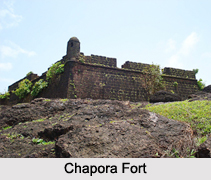 Chapora Fort is an Indian regional monument located in the state of Goa. More specifically, this fort is situated above the Chapora River, in Bardez. Bardez is a taluka in north Goa. Globally, Kanthkot Fort can be pinpointed at coordinates 15 degrees, 36 minutes, 22 seconds North and 73 degrees, 44 minutes, 11seconds East. This fort is also known as Shahpura. Shahpura translates into town of Shah in English. Chapora Fort is considered to be a famous tourist attraction of Goa and a major attraction for photographers for its sheer aesthetic beauty.
Chapora Fort is an Indian regional monument located in the state of Goa. More specifically, this fort is situated above the Chapora River, in Bardez. Bardez is a taluka in north Goa. Globally, Kanthkot Fort can be pinpointed at coordinates 15 degrees, 36 minutes, 22 seconds North and 73 degrees, 44 minutes, 11seconds East. This fort is also known as Shahpura. Shahpura translates into town of Shah in English. Chapora Fort is considered to be a famous tourist attraction of Goa and a major attraction for photographers for its sheer aesthetic beauty.
History of Chapora Fort
The Chapora is a replacement fort, built in place of a fort that was erected by ruler of Bijapur, Adil Shah. The Portuguese took control of Bardez in 1543. Chapora Fort was built by them in 1617. The Portuguese were continuously threatened by attacks, which were launched by the neighboring kingdoms. They were the Bahamani kings from the north, the Maratha horsemen from the east and the local chieftains in the area itself. To provide protection against the attacks of these enemies, the Portuguese thought of building a series of fortifications and executed this plan. The Chapora is one such fortification.
In 1684, the Portuguese and the Marathas battled. Resultantly, the Marathas turned out to be victorious and the Chapora was then ruled by the Maratha ruler, Sambhaji. But the locals opposed the rule of Marathas to such an extent that they withdrew their force from the region in 1717. The Portuguese again became the masters of the fort and had built the fort again. This time this newly developed fort was provided with underground tunnels. In 1739, the Marathas again took control of the Chapora fort. For the next two years, the Maharaja of Sawantwadi, also known as the ruler of Pernem, ruled over Chapora fort. It was in 1741, that the Portuguese again became the masters of the fort, when the northern taluka of Pednem came under their control. In 1892, the Portuguese completely left the Chapora fort.
Architectural Design of Chapora Fort
The Chapora Fort was constructed at a considerable elevation. It therefore has steep slopes on all sides and can provide scenic views in all directions or 360 degree view. This red laterite fort is an open space of stones and cashew bushes. Today, the Chapora Fort stands in a dilapidated condition. It is a place for a few herds of goats to graze. The main gate of the Chapora Fort is small, narrow, but deep. It is located at the top of the steep track. The boundary of the higher slopes forms the outer wall of the fort, which is irregular in shape. This wall acted as a protective barrier against the enemies, providing defensive height during the battles. It also prevented the formation of dry ditches in the area occupied by the fort. The fort is thus provided with ramparts (a wall-like ridge) over which one can walk and go around the fort. The walls are lined with arrow slits, gun ports and murder holes at regular intervals. The fort also has a protruding part called bastions, which are angled to the line of a wall. They function to permit defensive fire in different directions. The bastions of Chapora Fort have turrets. A turret is a small tower located on top of a larger tower or at the corner of a building or wall. These turrets are cylindrical in shape. This fort was also provided with two underground long tunnels, the heads of which are still visible today. They functioned as supply lines for the defending army and escape routes when faced unforeseen emergencies. The southern slopes of the hill have Muslim tombstones. They are considered to be as old as pre-colonial age and the remains of that time. A few barracks also exist today in Chapora Fort, which were built to house soldiers. Also, a church dedicated to St. Anthony once existed inside the fort.
Tourism of Chapora Fort
The Chapora Fort is a tourism product of Goa. One can indulge in adventure tourism by trekking up to Chapora Fort. The vast expanse of the Vagator Beach, Anjuna Beach and Chapora River as seen from the Chapora Fort, may transfix a person and make his trip memorable. This fort is also famous for picturesque sunset views and draws visitors to take a silent stroll around it. The sea in the vicinity of the fort is accessible by a natural valley, which is protected by rocky promontories.
Other Places of Attraction near Chapora Fort
Siddeshwar Temple, Chapora Beach and Vagator Beach are some of the other places of attraction near Chapora Fort.
Visiting Information
Chapora Fort has good transport availability. The nearest airport to Chapora Fort is Dabolim Airport in Goa. This airport is located at a distance of about 27 km from Chapora Fort. The nearest railway station to Chapora Fort is Thivim train station. This station is located at a distance of about 15 km from Chapora Fort. The road branching to the right, which is about 2 kilometers before the Vagator beach leads to Chapora Fort. Buses plying from Mapusa to Anjuna and Vagator stop near Chapora fort.
From Vagator beach, visitors would have to climb the hill to reach Chapora Fort.
Related Articles:
Monuments of Goa
Basilica of Bom Jesus
Pilar Monastery
Cabo de Rama Fort
Fortress of Colvale
Reis Magos Fort
Tiracol Fort
Cabo Raj Niwas



















